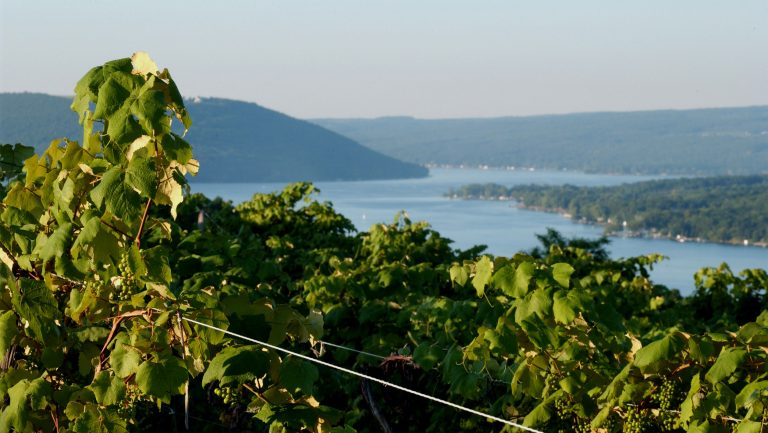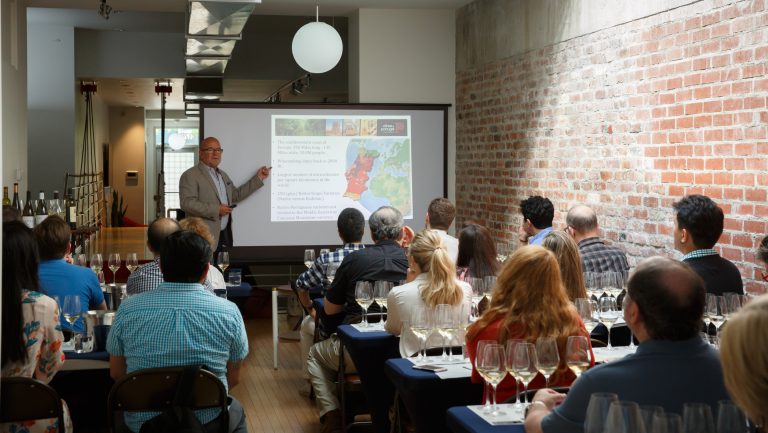This advertising content was produced in collaboration with our partner, New York Wine & Grape Foundation.
Every state in the U.S. is now producing wine, making it difficult to distinguish the serious regions from the rookies. But while New York might be less familiar as a wine region than its West Coast counterparts, it is by no means a fledgling wine producing state. In fact, it is the third-largest grape and wine producer in the U.S.—and the wines are better than ever.
“The overall base level of quality in New York wines has gotten better and better,” says Charlie Marshall, the chef and owner of The Marshal in Manhattan, which boasts an all-New York wine list. “And I think that level of pride makes people believe in their own success.”
Backed by a long tradition of winemaking, a penchant for experimentation, and an array of distinctive terroirs, New York State has proven to be a formidable winegrowing region on the world stage—and sommeliers, buyers, and consumers alike are taking notice. SevenFifty Daily investigates the innovation and energy in regions across New York to understand how the state is producing some of the country’s most interesting wines today.

Don’t miss the latest drinks industry news and insights. Sign up for our award-winning newsletters and get insider intel, resources, and trends delivered to your inbox every week.
A Foundation of Winemaking Experience
To call New York a “new” or “emerging” wine region isn’t entirely correct; though the local wine industry has really taken off in the last 50 to 60 years, the state is backed by nearly 200 years of viticultural experience. After all, the country’s oldest continuously operating winery isn’t located in California, as some might assume—it’s in New York’s Hudson River Region. The operation, Brotherhood Winery, was established in 1839, and many others emerged from the 1860s to the 1880s, particularly in the Finger Lakes region, leading the state to become known for solid sparkling, dessert, and table wines, largely made from hybrid grapes.
A new chapter for New York wine kicked off in the late 1950s, when Vitis vinifera vines made their way to the state via the Finger Lakes, first by Ukranian immigrant and viticulturist Dr. Konstantin Frank, who planted vinifera vines on Keuka Lake’s steep slopes. German-born Hermann J. Wiemer soon followed, planting vinifera varieties on Seneca Lake’s shores and founding a grafted grapevine nursery for other local vintners in the 1970s. This was well-timed—the establishment of New York’s Farm Winery Act of 1976 kicked off a slew of farm wineries throughout the state; there are now over 450 wineries and 1,600 family-owned vineyards across New York.
All of this history has allowed local vintners to hone their understanding of the land over the decades. After all, New York is home to incredibly diverse and unique terroirs, with 11 AVAs across eight regions, spanning four different degrees of latitude within the world’s “wine belt.” Three are the state’s best-known: Finger Lakes, Long Island, and Hudson River Region, each with its own distinctive climate, soils, and terroir nuances.
Though New York is generally home to a cool climate, and vintners across the state must manage conditions like humidity and cold snaps, Long Island’s Atlantic influences result in very different wines than the landlocked, glacial lakes of the Finger Lakes, for example. Strong partnerships between the New York Wine & Grape Foundation and academic institutions like Cornell University have helped winemakers and growers better understand their vineyards and adapt to their climate conditions; in the last year alone, there have been 18 new studies focusing on vital vineyard issues like winter bud hardiness and Cabernet Franc clone and rootstock selection for the Hudson River Region.
“Things have changed drastically,” says Christopher Bates, MS, the owner and winemaker of négociant-style producer Element Winery in Arkport. “We opened ourselves up to good, clean winemaking and that creates a sense of transparency, which has exposed us to the next area of focus, which is viticulture.”
Now, local grape-growers and vintners are drilling down on even more precise terroir specificities, resulting in the prevalence of site-specific cuvées and careful optimization of variety to vineyard location. All of this adds up to a more diverse range of characterful and distinctive wines from New York.
“We’re in the middle of one of the most diverse wine regions in the world, where you’ve got all these different climates,” says Marshall. “There’s just about nowhere in New York that can’t grow grapes.”
Experimentation Breeds Stylistic Diversity
The evolution of New York’s wine industry has largely been built upon a culture of experimentation, fueled by winemakers who come from all over the world to craft quality wines. This global influence is immediately evident in New York’s vineyard plantings; more than 40 wine grape varieties are grown in the state, from the Finger Lakes’ signature Riesling to classic Bordeaux varieties and offbeat grapes like Friulano and Saperavi.
“What’s really wonderful in New York is we were able to forge our own path and produce varieties that really are not seen elsewhere,” says Meaghan Frank, the vice president of Dr. Konstantin Frank Winery. “There’s been a lot of experimentation with varieties that are thriving and not really well known, like Rkatsiteli.”
New York is likely to continue attracting these global perspectives as well; now that the state’s terroir is becoming internationally recognized, renowned winemakers are putting down roots in New York’s vineyards, such as the Rhône Valley’s Louis Barruol with Forge Cellars on Seneca Lake.

While the Finger Lakes has become known for Riesling over the past few decades, local vintners have been experimenting with even more varieties and wine styles in recent years. The region’s red wines, made from varieties like Cabernet Franc, Lemberger, and Pinot Noir, are garnering attention for their depth and vibrancy, and there has been a return to the region’s tradition of sparkling winemaking.
“For me, the Finger Lakes is an exciting place because I can push things without them going over the top,” says Bates, who focuses on lesser-known varieties. “I have this ability to make a style of wine more in line with what I believe represents great wine in the wine world: herbal, savory, and minerally. ”Further downstate, where vineyards have typically been planted to a range of grapes and blended wines are common, curiosity and experimentation have resulted in a wonderful breadth of wines.
“It’s a culture of discovery, innovation, and open-mindedness, and that’s how my family and I approach it,” says Kareem Massoud, the president of the Long Island Wine Council and winemaker of Paumanok Vineyards and Palmer Vineyards on the North Fork of Long Island. “In the Old World, some may have their hands tied by tradition; we don’t have that.”
Alongside Long Island’s outstanding red, white, and rosé wines from familiar grapes like Merlot, Cabernet Franc, Sauvignon Blanc, and Chardonnay, some of the region’s most coveted bottles have been from obscure grapes, like Paumanok’s Chenin Blanc and Channing Daughters’ Blaufränkisch. This is true a few hours away in the Hudson River Region as well; a result of owner John Dyson’s travels to Italy, Tocai Friulano has become Millbrook Vineyards’ flagship grape.
It isn’t just vinifera varieties that New York vintners are experimenting with, either; in recent years, producers across the state have begun to make quality wines from cold-hardy hybrid grapes like Cayuga White and Catawba. “Not having the spotlight has created the effect of letting producers experiment and figure out what they’d like to do, and not be forced into a box,” says Frank.
Nationally Recognized and Locally Embraced
As the range and quality of New York wine continues to grow, trade professionals are embracing the state as a premier American wine-producing region. Many top New York City wine lists and retail shops include bottles from several of New York’s wine regions, and New York wines are increasingly being distributed across the country.
More buyers, particularly those in New York, are also realizing that sourcing high-quality wines from local wineries is far more sustainable than shipping cases across an ocean. “In the last five to eight years, I’ve had this awakening—it’s kind of silly to know more about Burgundy then what’s happening in the northeast and in New York,” says Yannick Benjamin, the owner of the forthcoming Contento restaurant in New York City. “How can you preach sustainability and environmental protection, and not preach local?”
Consumers are taking notice as well, making New York part of their regular wine-buying repertoire and exploring the many facets of the state’s wines. “People’s palates have evolved, and demand for things like rosé and sparkling wine are through the roof,” says Gabriella Macari, the general manager of Macari Vineyards on the North Fork of Long Island. “Consumers have changed for the better—they’re more educated, they’re drinking more wine, and already have an expectation that New York is making great wine.”
Though there’s never been a better time to buy, sell, or drink New York wine, stay tuned for what’s ahead in this exciting American region—New York’s wine renaissance is just beginning.

Dispatch
Sign up for our award-winning newsletter
Don’t miss the latest drinks industry news and insights—delivered to your inbox every week.










